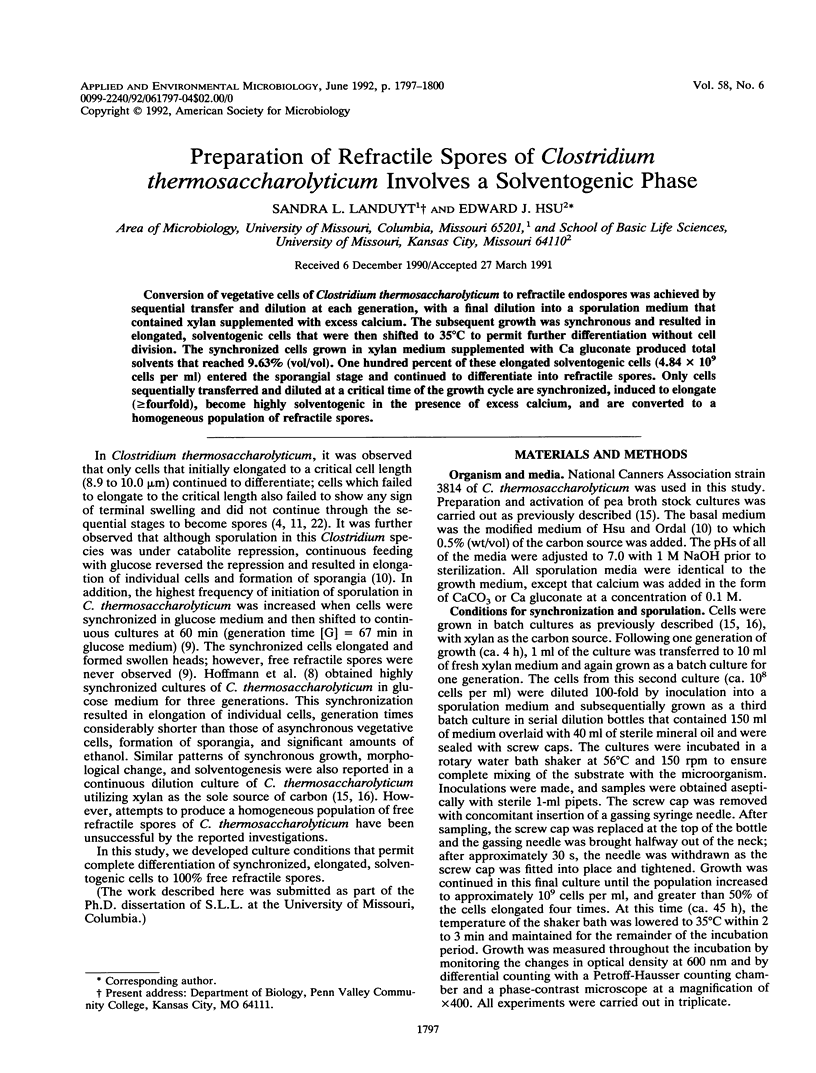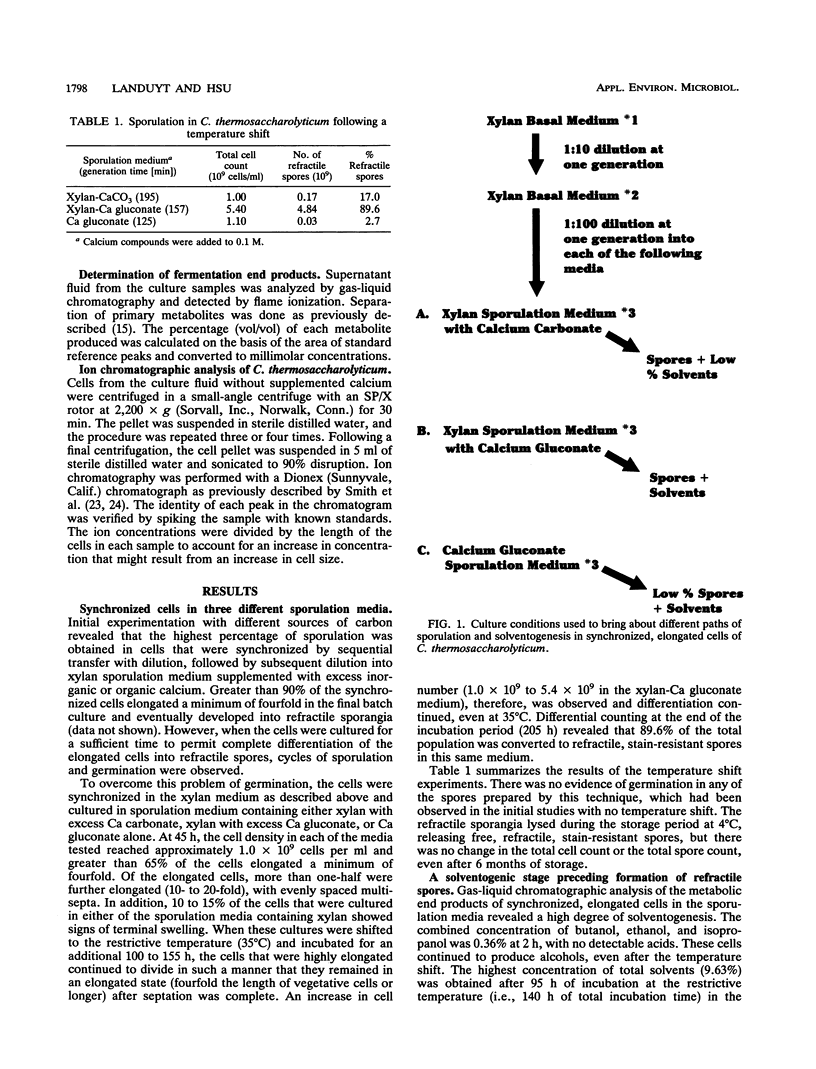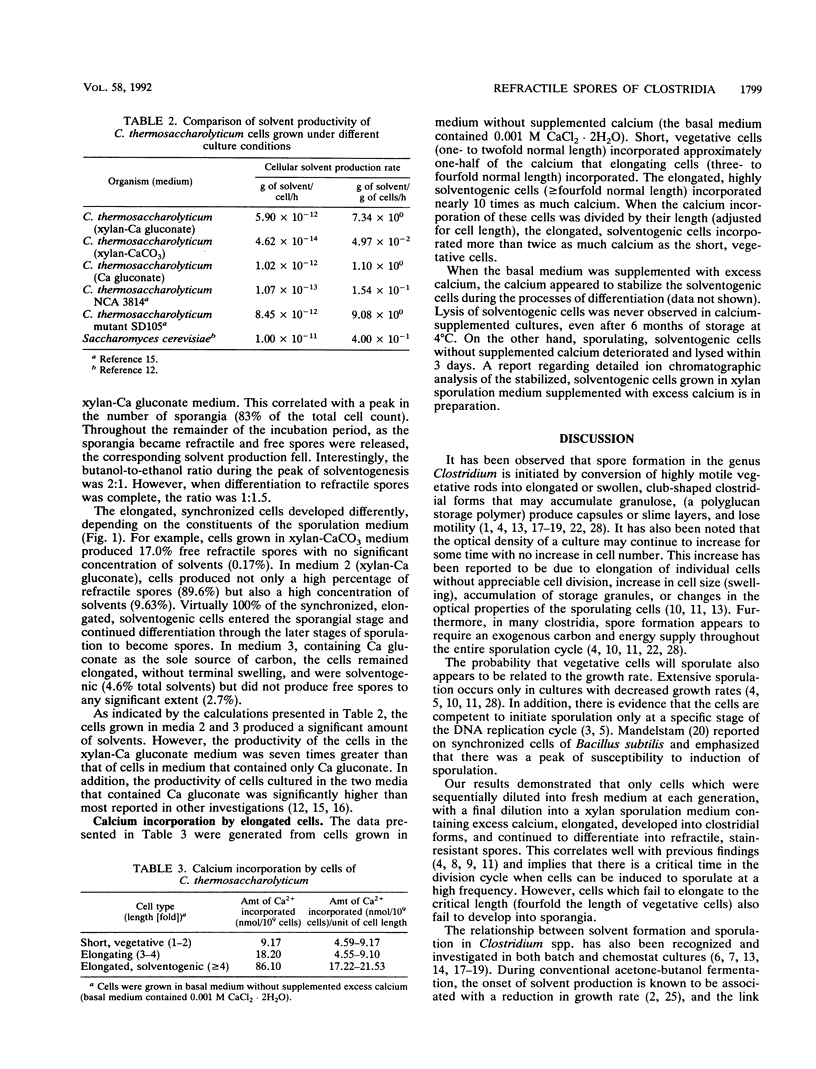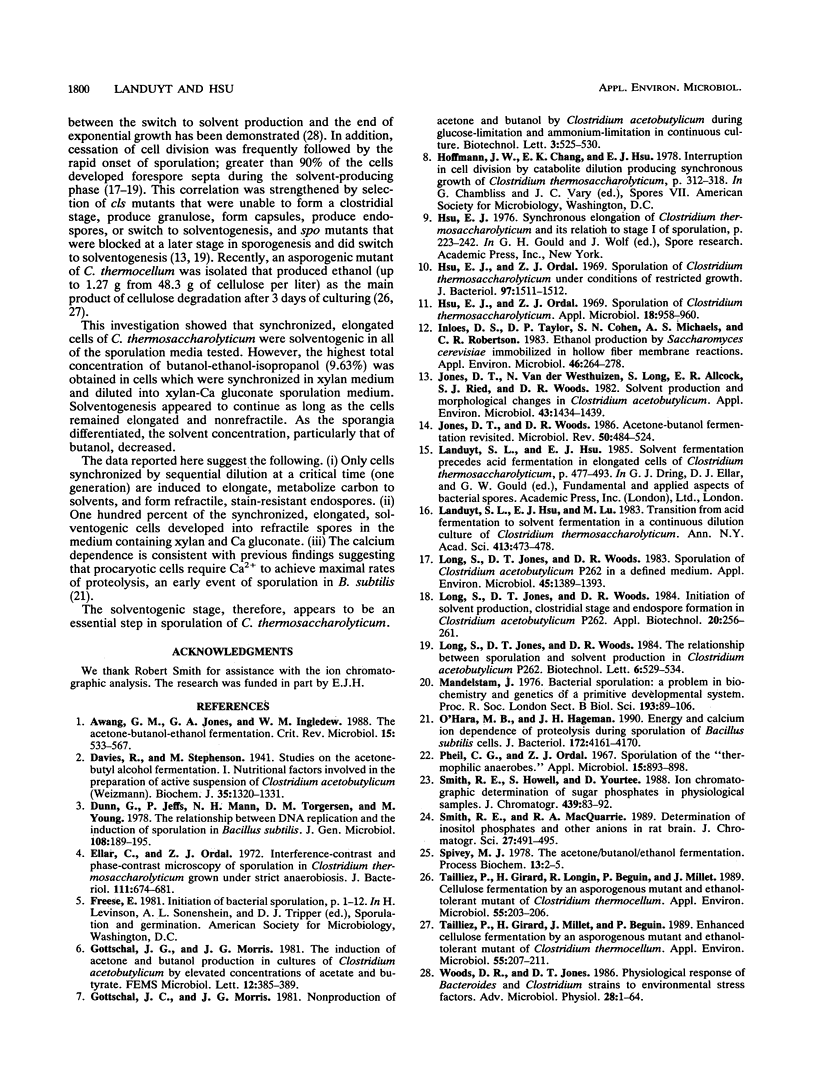Abstract
Conversion of vegetative cells of Clostridium thermosaccharolyticum to refractile endospores was achieved by sequential transfer and dilution at each generation, with a final dilution into a sporulation medium that contained xylan supplemented with excess calcium. The subsequent growth was synchronous and resulted in elongated, solventogenic cells that were then shifted to 35°C to permit further differentiation without cell division. The synchronized cells grown in xylan medium supplemented with Ca gluconate produced total solvents that reached 9.63% (vol/vol). One hundred percent of these elongated solventogenic cells (4.84 × 109 cells per ml) entered the sporangial stage and continued to differentiate into refractile spores. Only cells sequentially transferred and diluted at a critical time of the growth cycle are synchronized, induced to elongate (≥fourfold), become highly solventogenic in the presence of excess calcium, and are converted to a homogeneous population of refractile spores.
Full text
PDF



Selected References
These references are in PubMed. This may not be the complete list of references from this article.
- Davies R., Stephenson M. Studies on the acetone-butyl alcohol fermentation: Nutritional and other factors involved in the preparation of active suspensions of Cl. acetobutylicum (Weizmann). Biochem J. 1941 Dec;35(12):1320–1331. doi: 10.1042/bj0351320. [DOI] [PMC free article] [PubMed] [Google Scholar]
- Eller C., Ordal Z. J. Interference-contrast and phase-contrast microscopy of sporulation in clostridium thermosaccharolyticum grown under strict anaerobiosis. J Bacteriol. 1972 Sep;111(3):674–681. doi: 10.1128/jb.111.3.674-681.1972. [DOI] [PMC free article] [PubMed] [Google Scholar]
- Hsu E. J., Ordal Z. J. Sporulation of Clostridium thermosaccharolyticum under conditions of restricted growth. J Bacteriol. 1969 Mar;97(3):1511–1512. doi: 10.1128/jb.97.3.1511-1512.1969. [DOI] [PMC free article] [PubMed] [Google Scholar]
- Hsu E. J., Ordal Z. J. Sporulation of Clostridium thermosaccharolyticum. Appl Microbiol. 1969 Nov;18(5):958–960. doi: 10.1128/am.18.5.958-960.1969. [DOI] [PMC free article] [PubMed] [Google Scholar]
- Inloes D. S., Taylor D. P., Cohen S. N., Michaels A. S., Robertson C. R. Ethanol Production by Saccharomyces cerevisiae Immobilized in Hollow-Fiber Membrane Bioreactors. Appl Environ Microbiol. 1983 Jul;46(1):264–278. doi: 10.1128/aem.46.1.264-278.1983. [DOI] [PMC free article] [PubMed] [Google Scholar]
- Jones D. T., Woods D. R. Acetone-butanol fermentation revisited. Microbiol Rev. 1986 Dec;50(4):484–524. doi: 10.1128/mr.50.4.484-524.1986. [DOI] [PMC free article] [PubMed] [Google Scholar]
- Jones D. T., van der Westhuizen A., Long S., Allcock E. R., Reid S. J., Woods D. R. Solvent Production and Morphological Changes in Clostridium acetobutylicum. Appl Environ Microbiol. 1982 Jun;43(6):1434–1439. doi: 10.1128/aem.43.6.1434-1439.1982. [DOI] [PMC free article] [PubMed] [Google Scholar]
- Landuyt S. L., Hsu E. J., Lu M. Transition from acid fermentation to solvent fermentation in a continuous dilution culture of Clostridium thermosaccharolyticum. Ann N Y Acad Sci. 1983;413:473–478. doi: 10.1111/j.1749-6632.1983.tb47925.x. [DOI] [PubMed] [Google Scholar]
- Long S., Jones D. T., Woods D. R. Sporulation of Clostridium acetobutylicum P262 in a Defined Medium. Appl Environ Microbiol. 1983 Apr;45(4):1389–1393. doi: 10.1128/aem.45.4.1389-1393.1983. [DOI] [PMC free article] [PubMed] [Google Scholar]
- Mandelstam J. The Leeuwenhoek lecture, 1975: bacterial sporulation: a problem in the biochemistry and genetics of a primitive developmental system. Proc R Soc Lond B Biol Sci. 1976 Apr 13;193(1111):89–106. doi: 10.1098/rspb.1976.0033. [DOI] [PubMed] [Google Scholar]
- O'Hara M. B., Hageman J. H. Energy and calcium ion dependence of proteolysis during sporulation of Bacillus subtilis cells. J Bacteriol. 1990 Aug;172(8):4161–4170. doi: 10.1128/jb.172.8.4161-4170.1990. [DOI] [PMC free article] [PubMed] [Google Scholar]
- Pheil C. G., Ordal Z. J. Sporulation of the "thermophilic anaerobes". Appl Microbiol. 1967 Jul;15(4):893–898. doi: 10.1128/am.15.4.893-898.1967. [DOI] [PMC free article] [PubMed] [Google Scholar]
- Smith R. E., Howell S., Yourtee D., Premkumar N., Pond T., Sun G. Y., MacQuarrie R. A. Ion chromatographic determination of sugar phosphates in physiological samples. J Chromatogr. 1988 May 6;439(1):83–92. doi: 10.1016/s0021-9673(01)81677-0. [DOI] [PubMed] [Google Scholar]
- Smith R. E., MacQuarrie R. A., Jope R. S. Determination of inositol phosphates and other anions in rat brain. J Chromatogr Sci. 1989 Aug;27(8):491–495. doi: 10.1093/chromsci/27.8.491. [DOI] [PubMed] [Google Scholar]
- Tailliez P., Girard H., Longin R., Beguin P., Millet J. Cellulose Fermentation by an Asporogenous Mutant and an Ethanol-Tolerant Mutant of Clostridium thermocellum. Appl Environ Microbiol. 1989 Jan;55(1):203–206. doi: 10.1128/aem.55.1.203-206.1989. [DOI] [PMC free article] [PubMed] [Google Scholar]
- Tailliez P., Girard H., Millet J., Beguin P. Enhanced Cellulose Fermentation by an Asporogenous and Ethanol-Tolerant Mutant of Clostridium thermocellum. Appl Environ Microbiol. 1989 Jan;55(1):207–211. doi: 10.1128/aem.55.1.207-211.1989. [DOI] [PMC free article] [PubMed] [Google Scholar]
- Woods D. R., Jones D. T. Physiological responses of Bacteroides and Clostridium strains to environmental stress factors. Adv Microb Physiol. 1986;28:1–64. doi: 10.1016/s0065-2911(08)60236-2. [DOI] [PubMed] [Google Scholar]


